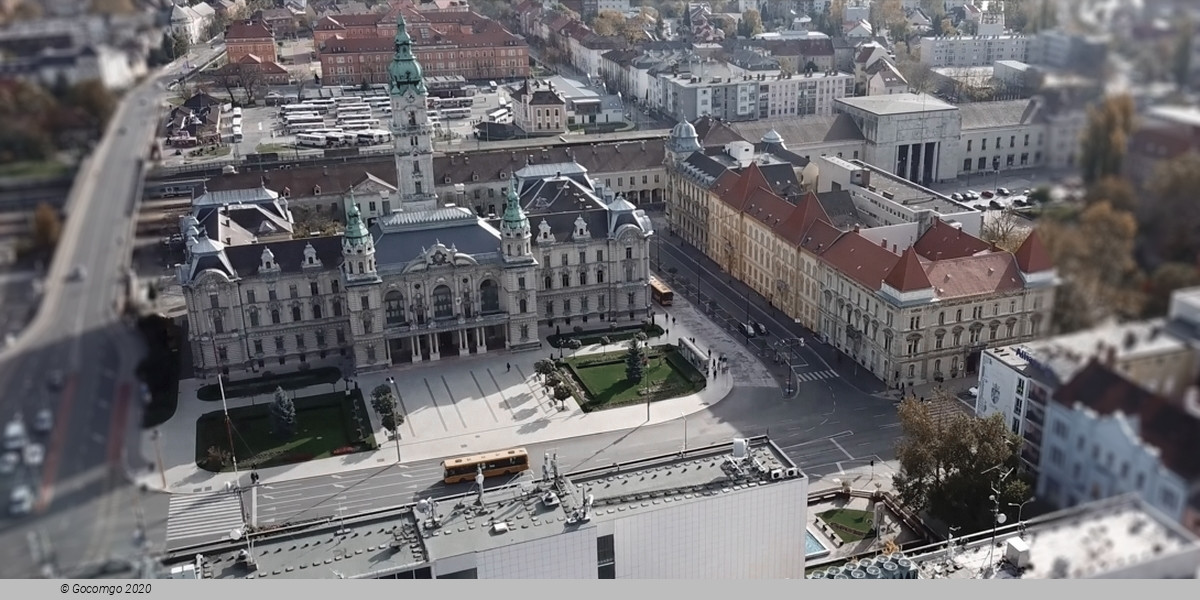Győr

Győr is the most important city of northwest Hungary, the capital of Győr-Moson-Sopron County and Western Transdanubia region, and—halfway between Budapest and Vienna—situated on one of the important roads of Central Europe. It is the sixth largest city in Hungary, and one of its seven main regional centres.
The area along the Danube River has been inhabited by varying cultures since ancient times. The first large settlement dates back to the 5th century BCE; the inhabitants were Celts. They called the town Ara Bona "Good altar", later contracted to Arrabona, a name which was used until the eighth century. Its shortened form is still used as the German (Raab) and Slovak (Ráb) names of the city.
Roman merchants moved to Arrabona during the 1st century BCE. Around 10 CE, the Roman army occupied the northern part of Western Hungary, which they called Pannonia. Although the Roman Empire abandoned the area in the 4th century due to constant attacks by the tribes living to the east, the town remained inhabited.
Around 500 the territory was settled by Slavs, in 547 by the Lombards, and in 568–c. 800 by the Avars, at that time under Frankish and Slavic influence. During this time it was called Rabba and later Raab. Between 880 and 894, it was part of Great Moravia, and then briefly under East Frankish dominance.
The Magyars occupied the town around 900 and fortified the abandoned Roman fortress. Stephen I, the first king of Hungary, founded an episcopate there. The town received its Hungarian name Győr. The Hungarians lived in tents, later in cottages, in what is now the southeastern part of the city centre. The town was affected by all the trials and tribulations of the history of Hungary: it was occupied by Mongols during the Mongol invasion (1241–1242) and then was destroyed by the Czech army in 1271.
After the disastrous battle of Mohács, Baron Tamás Nádasdy and Count György Cseszneky occupied the town for King Ferdinand I while John Zápolya also was attempting to annex it. During the Ottoman occupation of present-day central and eastern Hungary (1541 - late 17th century), Győr's commander Kristóf Lamberg thought it would be futile to try to defend the town from the Turkish army. He burned down the town and the Turkish forces found nothing but blackened ruins, hence the Turkish name for Győr, Yanık kale ("burnt castle").
During rebuilding, the town was surrounded with a castle and a city wall designed by the leading Italian builders of the era. The town changed in character during these years, with many new buildings built in Renaissance style, but the main square and the grid of streets remained.
In 1594, after the death of Count János Cseszneky, captain of Hungarian footsoldiers, the Ottoman army occupied the castle and the town. In 1598 the Hungarian and Austrian army took control of it again and occupied it. During the Turkish occupation the city was called Yanık Kala (burned place, as a reference to the enormous damages caused by the siege).
In 1683, the Turks returned briefly, only to leave after being defeated in the Battle of Vienna.
During the following centuries, the town became prosperous. In 1743 Győr was elevated to free royal town status by Maria Theresa. The religious orders of Jesuits and Carmelites settled there, building schools, churches, a hospital, and a monastery.
On 14 June 1809, during the War of the Fifth Coalition, this was the site of the Battle of Győr (Battle of Raab), where the army of Eugène de Beauharnais defeated the Hungarian "noble insurrection" (militia) and an Austrian corps under the Archdukes Joseph and Johann. Napoleon's forces occupied the castle and had some of its walls blown up. The leaders of the town soon realized that the old ramparts were not useful any more. Most of the ramparts were destroyed, allowing the town to expand.
In the mid-19th century, Győr's role in trade grew as steamship traffic on the River Danube began. The town lost its importance in trade when the railway line between Budapest and Kanizsa superseded river traffic after 1861. The town leaders compensated for this loss with industrialisation. The town prospered until World War II when several buildings were destroyed. Some large-scale Strategic bombing devastated industrial and residential areas as well as the airport. It was targeted because the Rába factory was a main tank (Turán) and aeroplane (Bf 109) producer. One of these raids destroyed some parts of the maternity hospital.
The 1950s and '60s brought more change: only big blocks of flats were built, and the old historical buildings were not given care or attention. In the 1970s the reconstruction of the city centre began; old buildings were restored and reconstructed. In 1989 Győr won the European award for the protection of monuments.
A 100-year-old Raba factory on the River Danube close to the historical centre is to be replaced by a new community called Városrét. The mixed-use community will have residential and commercial space as well as schools, clinics and parks.
The city's main theatre is the National Theatre of Győr, finished in 1978. It features large ceramic ornaments made by Victor Vasarely.
The city has several historical buildings, for example the castle, and the Lutheran Evangelic church.

